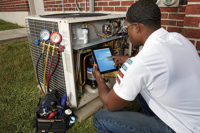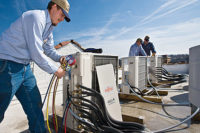HVAC technicians routinely encounter a wide variety of thermostats in homes and buildings, from the basic dial-face thermostats to cloud-based intelligent units that can learn an occupant’s schedule and literally program themselves.
With so many options, how do you help your customers select the best thermostats for their lifestyles, and what do you do if that thermostat isn’t working the way it’s supposed to?
Choosing the Right One
Whether customers are replacing a thermostat or installing an entire new system, it’s often up to the technicians to help homeowners select equipment that best meets their needs. Russ Donnici, president of Mechanical Air Service Inc., San Jose, Calif., said his team typically starts the process by asking a mix of questions.
“We will typically ask homeowners how they use the home, and generally, if no one is home during the day, we will use a thermostat with a 5-2 schedule. If they have someone home during the day, we will use a seven-day programmable thermostat. We also ask if they want Wi-Fi access to the thermostat and select a unit based on their answers.”
Butch Welsch, president of Welsch Heating & Cooling Co., St. Louis, agreed that listening to the customer is crucial.
“We help our customers choose the right thermostat by spending some time with them to determine their wants, needs, and capabilities,” Welsch said. “Are they really interested in the programming features? Is remote control via Wi-Fi an important feature for them? These questions are important because we are reluctant to install a thermostat with extra features that the customer won’t be using.”
Ted Petersen, an HVAC technician at Thornton and Grooms, Farmington Hills, Mich., said it helps to provide options to the customer. “You really need to ask the proper questions and get an idea of the customer’s lifestyle or business operation,” he said. “After getting that information, you can put some options together for that customer.”
The right thermostat has to also properly fit a customer’s budget, said Jack Floyd, energy and automation specialist at AirTight Mechanical Inc., Charlotte, N.C.
“Thermostats today can range from $50 to $1,000, depending on what application they are to be used in,” Floyd said. “If a customer has a smart building, then they need a smart thermostat to match the technology already in place. If they have a basic installation, then usually we will recommend at least a seven-day programmable thermostat. You would be surprised at how much energy you can save by putting schedules in place to control your HVAC system.”
Finally, Welsch pointed out that while high-tech thermostats may be appealing to some, they are definitely not for everybody, and the HVAC technician needs to make sure the end user will actually be able to operate the thermostat once it is installed.
“It can be extremely frustrating to a customer to have a great-looking thermostat that supposedly has a lot of features, yet they have no concept or ability to operate that thermostat,” Welsch said.
Not Enough Wires
Once a customer has settled on a thermostat, that doesn’t necessarily mean the hardest part is over. A common problem during installation, Welsch said, is not having enough wires when transitioning from an older unit to a newer one.
“Many of the older thermostats did not require as many wires, and so it becomes necessary to pull additional wires in order to have proper operation of many of the new, more sophisticated thermostats,” Welsch explained.
Ken Misiewicz, CEO of Pleune Service Co., Grand Rapids, Mich., agreed that wiring issues are the most common problem when installing a new thermostat.
“It usually revolves around the wiring, such as needing a common wire — and not always having the extra wire — when switching from a mercury or battery-powered thermostat,” he said. “Or, wires that are too short and tangled to make an easy transition to a new sub base, needing shielded wires (or not) for remote sensors, and improperly color-coded wires.”
To combat wiring issues, Floyd said his team usually starts from the ground and work its way up.
“Typically, we will disconnect all the wiring, test the wires, and then properly label and wire the controller or thermostat from scratch,” he said. “In the long run, you end up with less labor as you are not chasing a ghost from the past to determine what was actually causing the problem.”
Troubleshooting Tips
Aside from wiring problems, several other issues often plague thermostat installations. The first step, Welsch said, is to see if the problem is a simple one that can be solved remotely before sending out a technician.
“We first attempt to find the source of a customer’s problem over the phone,” Welsch said. “We always ask the customer if they have a display on the thermostat. Many times the problem is just that the batteries have gone bad and most customers don’t even realize there are batteries in the thermostat.”
“A common problem is that service technicians either don’t know to, or forget to, seal the hole where the wires enter the thermostat,” Donnici said. “If you don’t seal the hole, the air movement inside the wall can and will influence the thermostat operation. Only in the past few years have homes been sealed well, but we never assume it, and we always seal the hole.”
In addition to contractor error, a major cause of thermostat issues is improper installation by the homeowners themselves.
“Many times we run into situations where a homeowner installs a thermostat he purchased from a big-box store, and either purchased the wrong type, did not set the switches correctly, or worse — wired it wrong and shorted the transformer,” said Rich Morgan, CEO of Magic Touch Mechanical, Mesa, Ariz. “We typically start by finding out who installed it and when.”
David Kyle, founder of Trademasters Service Corp., Lorton, Va., also stressed the importance of performing a thorough inspection of the entire system before diagnosing a problem.
“We frequently receive calls where the problem reported is a bad thermostat,” he said, “but that is rarely the case.”
If the problem does turn out to be the thermostat, replacing the device rather than repairing it may be the most economical decision for the homeowner.
“The price to try and repair a thermostat is often higher than putting in a digital, higher-performance programmable — or even Wi-Fi-compatible — thermostat,” said Travis Smith, general manager, Sky Heating & Air Conditioning, Portland, Ore. “With older thermostats, we usually just replace them.”
Finally, Floyd said the most important thing a technician can do to troubleshoot a thermostat is his or her homework.
“Read the manual,” Floyd said. “Knowing how the product you are working on is supposed to work is half the battle in installing or repairing it. There is no way to learn every model, as there are just too many, but if you use your resources, you do not need to know them all — just where to find the manual.”
Publication date: 9/23/2013
Want more HVAC industry news and information? Join The NEWS on Facebook, Twitter, and LinkedIn today!









